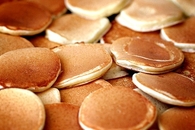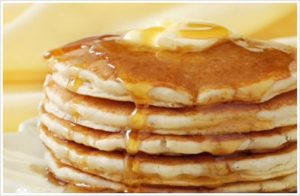
Plaatkoekies are the boerekos version of American breakfast pancakes. Except they are about a million times better, of course, and we don’t have them only for breakfast, but for brunch, teatime and supper too. In fact, plaatkoekies make one of the finest Sunday suppers any child could wish for – served still hot from the pan, drowned in melting butter and capped with a peak of grated yellow cheese under a sludge of runny honey. Or golden syrup, straight out of the Tate and Lyle’s tin, with all its wickedly sweet, burnt-sugar, caramelly goodness.
I am not sure exactly which strain of our culinary heritage we have to thank for flapjacks – which is what plaatkoekies are also called – and have more than a suspicion that they could be of Irish or Scottish origin. There was a time when the Afrikaners, Scots and Irish rather enthusiastically embraced one another through marriage and other alliances, no doubt largely to annoy the English, whom everyone agreed were Thoroughly Bad. Lucky for us, political tensions eventually eased, by which time flapjacks had arrived in our kitchens to stay.
This recipe is from my Ouma Hettie, and has been in use in its given form for over 70 years. That is one seriously tried and tested recipe, my friend. I found it in my mom’s last remaining handwritten recipe book and was stunned by how good it was the first time I made it. If you’ve only ever had flapjacks made from ready-mixes sold in packets, you’ve been conned. Correct this sad state of affairs immediately by getting some eggs, flour and milk, and whipping up a proper batter for this real makoya of flapjacks.
Cook’s tip: for the best results, follow the recipe below exactly, and that means adding the milk and oil slowly, bit by bit, rather than all in one go. When I tried the latter method in order to speed things up – that modern malaise of always having to speed everything up – the flapjacks were still damn tasty, but lacked that ‘OMG I can’t believe what I’ve just tasted’ amazingness that the old-fashioned method delivers.
These plaatkoekies deserve to take centre place at your next lazy weekend brunch. Serve with crème fraîche, honey, toasted almond flakes and fresh banana, or salty, sticky chipolatas, bacon and maple syrup, or whipped mascarpone and smoked salmon trout if you want to show off. Alternatively, just load them up with butter, grated cheese and syrup and off you go to food heaven.
Ouma Hettie se Plaatkoekies – Flapjacks
Makes about 18-20 flapjacks, enough for 4-6 people.
The batter will keep for up to one day in the refrigerator.
Ingredients:
2 cups (350g) cake flour, unsifted
½ t (2,5 ml) salt
1 T (15 ml) baking powder
3 T (45 ml) sugar
1 egg
1 ¾ cups (430 ml) milk
¼ cup (60 ml) sunflower oil
Extra oil for baking
Method:
- Sift dry ingredients together in large mixing bowl or your blender’s bowl.
- Beat the egg very well with only 1 cup (250 ml) of the milk, until completely smooth. Add to dry ingredients and beat for exactly one minute – no less, no more.
- Now add the remainder of the milk slowly, while the beater is still running, and then the oil, 1 T (15 ml) at a time. Beat the batter for exactly one minute after all the ingredients have been added, and then let stand for 30 minutes. The batter can also now be stored in the refrigerator for up to 24 hours – beat lightly for 30 seconds before using.
- Heat 3 T (45 ml) oil in a heavy-bottomed frying pan over medium heat. When the oil is hot, pour out excess oil into a heat-resistant bowl to use again later. Leave only a thin film of oil coating the bottom of the pan and wipe lightly with bunched-up absorbent kitchen paper.
- Ladle or pour spoonfuls of batter into the hot pan and bake without turning until small holes form in the top of the flapjacks. Flip over immediately, using a metal spatula.
- Bake until golden brown on both sides, remove from pan and keep warm while you use up the rest of the batter.
- Wipe the bottom of the pan with kitchen paper lightly dipped in oil before baking each fresh batch of flapjacks.
COOK’S TIP: For best results, don’t turn the heat too high and keep toggling the heat so that the flapjacks don’t scorch on the outside while remaining uncooked on the inside. Practise makes perfect! Keep flapjacks warm in a large metal oven tray at 100 C, and don’t stack them on top of each other, so they don’t go soggy. Best eaten as soon as you’ve prepared them.
